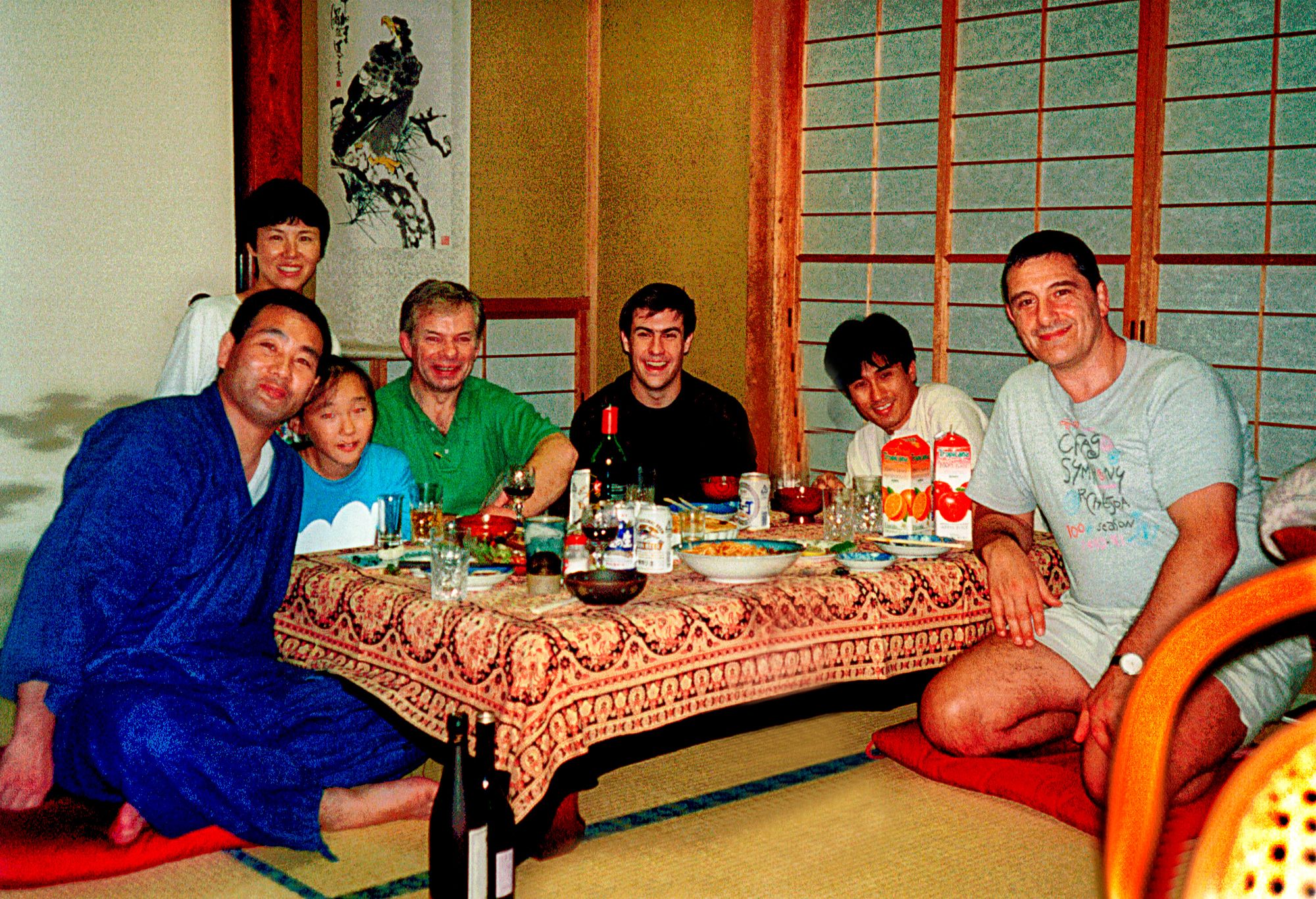One of the most fascinating things about judo is how it’s constantly evolving. Much of that evolution has been caused by rule changes. As new rules and restrictions are put in place, players and coaches come up with creative solutions to get around the rules.
Take for example the side takedown (also known as the Laats Takedown). This technique traditional involves a leg grab. When leg grabs were first banned, people thought that would be the end of that technique. I was quite upset because the side takedown was one of the techniques that I did (and liked a lot).
An Austrian judoka who was living in Malaysia had made a trip back to his home country and when he returned, he showed me how the players there were modifying the side takedown so that it didn’t have to involve a leg grab (it involved taking a two-on-one grip on uke's arm).
I immediately put it to use and even managed to throw him a few times during randori that night itself. “Now, I regret showing it to you,” he said afterwards, with a smile.
Another technique that I thought would go the way of the Dodo Bird is the Khabarelli technique, which requires taking hold of uke’s trousers. I couldn’t imagine how any modification could work without a leg grab.
Turns out I didn’t have to imagine it. The Georgians figured it out, which is appropriate I guess since that technique originated from Georgia. Instead of grabbing the trousers, they grabbed the side of uke’s belt where the target leg was. You wouldn’t think this modification would work but Mindia Bodaveli (son of the legendary Khabarelli expert David Bodaveli) made it work perfectly in IJF competitions. After that many players from around the world copied his approach.
Not all innovations come as a result of rule changes. Some happen due to personal circumstances. Toshihiko Koga’s unusual approach to doing ippon-seoi nage (he takes a left stance and a left grip but throws to the right) is a result of his older brother’s influence. How his brother came up with that is unclear. Neil Adams says he is not sure how he came up with his special Figure-4 juji-gatame roll but says it probably came from wrestling (his older brother was a wrestler).
Sometimes innovation is sparked by injury. One of the most unique and innovative players to have ever come out of Japan is 1981 World Champion Katsuhiko Kashiwazaki. He used to do morote-seoi-nage but after severely injuring his arm, he couldn’t do that technique anymore and decided to rely on sacrifice techniques, particularly tomoe-nage. He also did techniques like hikikomi-gaeshi and all kinds of takedowns but tomoe-nage was particularly dear to his heart, so much so that he named his own daughter Tomoe.
Kashiwazaki was an expert at tomoe-nage and he could do all kinds of versions of it but the one he is most famous for is a variation of the yoko-tomoe-nage, which he calls “furiko-tomoe-nage” (pendulum tomoe-nage). He used this very technique in the final of the 1981 World Championships. It created so much momentum, his opponent overspun, so no ippon was given (in fact, initially only a koka was given, though it was quickly changed to yuko). Kashiwazaki was a strong newaza man so he proceeded to secure an osaekomi on his opponent using another of his trademark techniques, which he called obi-tori-gaeshi.
The interesting thing about Kashiwazaki is that he is not as famous in Japan as he is in Europe. After his retirement from competition, he was sent by the All-Japan Judo Federation to stay in London for a year to learn English. The federation tended to send future coaches to London to learn English. Kosei Inoue, the current head coach of Japan, was also sent to the UK for a year, although he only spent part of his time in London (the other part in Scotland).
When Kashiwazaki was in London in the mid-1980s, he taught judo at The Budokwai, Europe’s oldest judo club. The Budokwai was a rather unusual club in that it had a mix of some very top athletes as well as some very prominent members of London society.
Angelo Parisi, who won an Olympic bronze for Great Britain, and later two Olympic silvers and an Olympic gold for France, got his start at The Budokwai. Neil Adams used The Budokwai as his base during his active years as a competitor, as did Olympic silver medalist Ray Stevens.
Many famous personalities also trained there. Singers Kylie Minogue, Simon Le Bon (lead singer of Duran Duran) and Mick Jagger have all trained there. So did British politician William Hague who regularly partnered double Olympic gold medal runner (1500m) Sebastian Coe.
I didn’t get to meet any of these people because their time at The Budokwai didn’t coincide with mine. But I did meet Mark Law, an editor at The Daily Telegraph and author of the acclaimed book “Falling Hard, a Journey into the World of Judo”.
In fact, I first met Mark when he was a white belt just starting out in judo. He had just turned 50 and to celebrate his half a century of being alive, he decided to take up judo. Needless to say, he fell hard for the sport.
I lost contact with Mark after I left London but many years later when I was visiting London to help Neil Adams do his book “Judo Evolution”, Mark heard that I was in town and invited me to visit his flat for a cup of tea. By then, he had authored his famous book (considered one of the best books on judo ever) and was already a black belt. We had a good time reminiscing about his early days at The Budokwai and the randoris we did together.
Another famous person I met was the late Terence Donovan, famed for his fashion photography in the 1960s. Donovan, a black belt himself, was very taken by Kashiwazaki and collaborated with him to create a coffee table book called “Fighting Judo”. It featured beautiful, artistic photos of Kashiwazaki doing his highly unusual brand of judo.
When someone pointed out to me that Terence Donovan was on the mat, I walked up to him and said, “Mr Donovan, I’m a big fan of your work.” He smiled and said, “Oh, you like ‘Addicted To Love”?
“What... you produced ‘Addicted To Love’?” I asked, stunned. “I directed the video,” he replied, with a chuckle. I explained that what I was actually referring to was “Fighting Judo”. Oh, that, he said. “Yeah, Kashiwazaki’s brilliant, isn't he?”
Another prominent figure who trained at The Budokwai was journalist and publisher Nicolas Soames. He too was taken by Kashiwazaki and produced two specialist books by him. One was called “Tomoe-Nage” and the other was “Shimewaza”.
This trio of books: “Fighting Judo”, “Tomoe-Nage” and “Shimewaza” spread Kashiwazaki’s name far and wide in the Western world. He was incredibly popular in the USA and across Europe, especially in the UK and Germany. By the mid-90s, he was a household name among European judokas.
My time in London did not coincide with his but I did get to meet Kashiwazaki in 1995 when I visited Kokusai Budo Daigaku (International Budo University) in Chiba, Japan, where he was the head coach for judo. He invited us for a traditional Japanese meal at his home, where I got to meet his family, including his daughter Tomoe.

In many ways, Kashiwazaki is a conservative, traditional Japanese male. For example, he doesn’t believe his wife should get out of the car before he did. But when it came to judo, he was completely non-traditional. There was nothing classical or conservative about his techniques or the way he demonstrated them.
And this makes him very different from most Japanese judoka. If you read instructional books or watch instructional videos by Japanese champions, you’ll find they always demonstrate the standard Kodokan version of techniques, which frustrates judo enthusiasts like me. I want to see how they really do it, not the classical version where I can find in any standard judo textbook!
I once asked the Japanese American coach, Shintaro Higashi, why Japanese champions tend to demonstrate Kodokan versions of the technique and not how they really do it. “I’m not sure but you are right, they only demonstrate the classical version,” he said. I guess he didn’t know the reason because he was more American than Japanese. Shintaro demonstrates a lot of non-classical techniques in his YouTube videos.
I think it has to do with conformity. Japanese champions feel pressure to show the “correct” way of doing things, and of course the “correct” way is the Kodokan way, not necessarily the way it is done at the World Championships or the Olympics.
Well, Kashiwazaki didn’t care about that. He showed his judo the way he did it, which was really unique, in an out-of-this-world kind of way. You really have to see “Fighting Judo” to understand what I mean. It's totally original and has nothing resembling the Gokyo in it. It's really quite a book. Unfortunately, it's been long been out of print (a tattered, second-hand copy can be found on Amazon for US$248.29 if you're really interested).
I can’t say my judo is influenced by Kashiwazaki. Of course, I learned how to do the furiko-tomoe-nage but my yoko-tomoe-nage is not based on that. I also like to do newaza but my groundwork is more influenced by Neil Adams. I guess Kashiwazaki’s influence on my judo is more philosophical, which is to discard tradition if it doesn’t serve you well. Judo is a dynamic, constantly-evolving sport so we have to embrace change and think creatively, even if this flies in the face of tradition.
In the late-90s there was a Japanese judo coach named Kudo, based in Malaysia, who upon seeing me do the side takedown for the first time, remarked: “That’s not really judo.” So, what did I do? I had a randori with him and threw him for ippon with it. To his credit, he got up, laughed, and said, “Good throw”.
